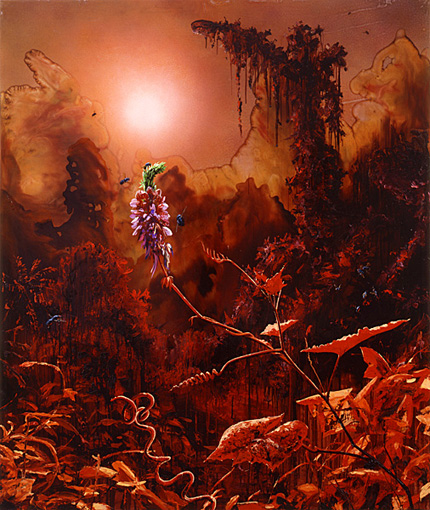
East 82nd Street, 2007, oil on wood, 80 x 68 in., from Alexis Rockman's American Icons series depicting future landscapes ravaged by climate change. Courtesy Alexis Rockman
“None of us were prepared for the sight of the Louisiana Superdome lapped by floodwaters and with strips of its roof peeled back by the winds of Hurricane Katrina. In that image we glimpsed the predicament of our moment, a human world newly and suddenly vulnerable to the forces of a changed planet. But if we’d been looking at the paintings made over the last two decades by Alexis Rockman, we’d at least have had some practice in how to see it. In an era when artists have obsessed mostly about the fractures within human society — class, gender, race — Rockman has been among the very few trying to understand the deep, mysterious and crucial cleavage between the human and natural worlds. He is, in fact, one of the few philosophers working this critical terrain.” — from Bill McKibben, “The Present Future: Paintings for a Hot Planet,” Orion Magazine, January/February 2006
“The American Icons paintings are as specific as their subject is far-reaching. Recognizable emblems of patriotism such as the U.S. Capitol and Mount Rushmore, bastions of frivolity and greed such as Las Vegas and Hollywood, and tourist meccas such as Disney World all suffer the same leveling fate when it comes to the status-blind and whimsical response of our planet. The Capitol building looks like a wedding cake, several weeks after the party’s ended. The St. Louis Arch has been strangled by invasive kudzu. The esteemed profiles chiseled into Mount Rushmore — including that of Theodore Roosevelt, the father of modern conservation in the United States — are up to their chins in murky water.” — from Dorothy Spears, “Introduction,” Big Weather/American Icons (Leo Koenig Gallery, 2006)
Alexis Rockman's work is in the Whitney Museum of American Art, the Guggenheim Museum, the Museum of Contemporary Art in Los Angeles and London's Saatchi Collection. He is currently contributing to the production of Ang Lee’s film Life of Pi.

Comments [3]
11.05.09
01:47
11.09.09
02:15
11.11.09
06:32